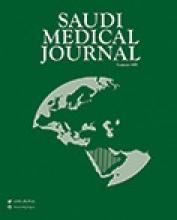Abstract
OBJECTIVE: To determine the trend of health care associated blood stream infection (HA-BSI) at Saudi Aramco Medical Services Organization.
METHODS: This prospective survey was conducted during the year 2002-2006. Definitions of HA-BSI infections were based on the Centers for Disease Control and Prevention categories.
RESULTS: There were a total of 1103 distinct episodes of HA-BSI with annual average rates of 8.5 per 1000 discharges and 18 per 10,000 patient-days. Of all episodes, 38% were primary, 47% were central line-associated bloodstream infection (CLABSI), and the remaining 15% were secondary bacteremias. The hospital wide BSI rate per 1000 discharges increased from 7.8 to 11.9 (p<0.001). Secondary bacteremia remained relatively stable over the study period at 3/10,000 patient-days (p=0.41). Primary BSI increased from 6.9 to 10.6 per 10,000 patient-days (p<0.001). Hospital wide CLABSI increased from 3.2 to 6 per 1000 discharges (p<0.001) and from 7 to 11.8 per 10,000 patient-days (p=0.039). Coagulase negative staphylococcus was the leading pathogen (23.7%) followed by Staphylococcus aureus (11.1%) and Escherichia coli (11.1%). Of all episodes, candida caused 5%, Klebsiella pneumoniae (9%) and Pseudomonas aeruginosa (7.3%).
CONCLUSION: The rate of secondary BSI remained relatively stable over the study period. However, primary BSI and CLABSI increased over time. Coagulase negative staphylococcus, Staphylococcus aureus, and Escherichia coli were the most frequent microorganisms.
- Copyright: © Saudi Medical Journal
This is an open-access article distributed under the terms of the Creative Commons Attribution-Noncommercial-Share Alike 3.0 Unported, which permits unrestricted use, distribution, and reproduction in any medium, provided the original work is properly cited.






